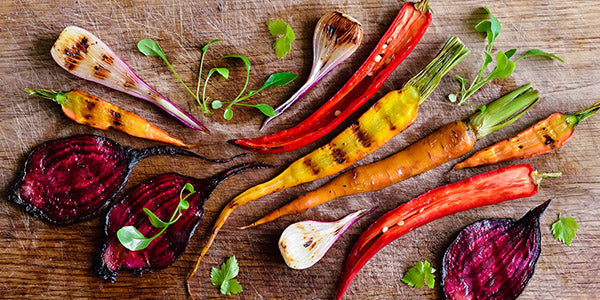
Home chefs who are shy to enter new culinary territories often cook up excuses not to grill. But you don not have to be a grill master to cook up a nutritious spread of crisp and succulent vegetables to be eaten plain or coupled with soups, stews, and savory entrees.
With the optimal grilling technique, you can retain the moisture of vegetables while enhancing their potent, hidden flavors and impressing your dinner guests. Use the following techniques to learn how to grill vegetables to charred perfection any day of the week.
How to Grill Vegetables for the Best Flavor
Grilling the best veggies requires careful selection, prepping techniques, and firing up the grill!
Choose Which Veggies to Grill
The most critical decision when learning how to grill vegetables is choosing vegetables that can withstand the high heat of a grill flame.
Asparagus, mushrooms, potatoes, bell and poblano peppers, eggplant, and onions are ideally suited for grilling due to their heartiness and their ability to confer a caramelized sheen and smoky flavor that is pleasing to the eye and taste buds once cooked. Corn also makes a superb choice for handheld, grilled eats, as its husk serves as a tidy wrapper to prevent a messy dining experience.
If planning to prepare vegetable kebabs, choose small and vibrant vegetables that can easily be skewered, such as cherry tomatoes or sliced vegetables like zucchini or yellow squash. When preparing kebabs consider mixing and matching vegetables with complementary flavor profiles, such as pairing the subtle flavor of mushrooms with bold and robust onions.
Avoid vegetables with high water contents, such as cucumbers, leafy greens, or celery. These vegetables are apt to fall apart or dehydrate when in contact with the heat of a grill.
Prep the Veggies
When learning how to grill vegetables, it is important to know the optimal size at which vegetables should be cut in order for all of the vegetables to be cooked by roughly the same time rather than in delayed stages.
Dense vegetables like potatoes take longer to cook in general, so they should ideally be cut into smaller chunks to expedite grilling time. Self-contained vegetables like corn cobs can be left in their natural state to preserve their juices and retain the moisture of the kernels.
When preparing vegetable kebabs, aim to cut all of the vegetables on a skewer into roughly equivalent-sized pieces to ensure predictable cooking completion time and that every vegetable receives equal exposure to the heat.
Oil and Season to Liking
To prevent dry vegetables from sticking to the grill, moisten them in a pre-prepared marinade or brush them with olive oil before placing them on the grill rack. Prevent grill flare-ups by discarding excess, dripping oil.
Additionally, season your vegetables with fresh herbs like thyme and sage to infuse aromatics that illuminate the natural flavors in the vegetables.
Fire Up the Grill
While a subtle char on grilled vegetables is desirable, burned vegetables are unpalatable for the even the most adventurous diners. Avoid burning your vegetables by assessing the cooking time of each vegetable before you place them on the grill. To ensure that all vegetables are cooked at approximately the same time, place denser vegetables that require more cooking time on the grill before smaller vegetables that cook faster.
For a distinct sear and hint of smokiness on the outside of vegetables with a tender, moist texture on the inside, you can initially place vegetables on a higher heat portion of the grill before moving them to a cooler area of the grill to complete cooking.
If you're ready to leave the heat of the kitchen and fire up your weight loss plan, bistroMD's diet delivery service can help with a variety of nutritious, gourmet entrees - like Grilled Salmon Teriyaki and Grilled Chicken Pesto - that you can enjoy in the comfort of your own home.





